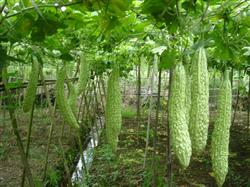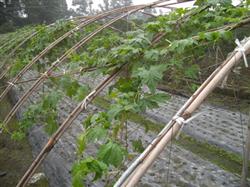How to manage the cultivation of balsam pear in the middle and later stage

How should the cultivation of balsam pear be managed in the middle and later period? Please introduce management methods to cultivate balsam pear in the middle and later stage, we can refer to the following methods for management: first, from the seedling stage, balsam pear should be ploughed, weeded and cultivated in time to prevent soil consolidation. Generally, after planting and watering slow seedlings, the first intertillage will be carried out when the topsoil is slightly dry and not sticky. If the soil is too dry or windy, it can be rewatered and then ploughed again. The second intertillage can be carried out 15 days after the first intertillage. This time, attention should be paid to protecting the new roots, which should be shallow rather than deep. Each ploughing can be combined with the application of some high-quality farm fertilizer, such as cake fertilizer, all kinds of poultry feathers and rotten chicken manure, pig manure and so on. After setting up the frame, when the melon vine extends to more than 50 centimeters, the root system is basically covered with the whole row, so it is generally no longer suitable for ploughing. However, attention should be paid to timely pulling out weeds and preventing weeds from growing, so as to improve the ventilation and light transmission conditions in the field and reduce the damage of diseases and insect pests. In the first ploughing, if a lack of seedlings or weak diseased seedlings are found, they should be replanted in time to preserve the seedlings. Second, erection and pruning when balsam pear seedlings grow to about 20 centimeters, it is necessary to draw vines. There are two ways to build scaffolding: flat scaffolding and herringbone scaffolding. The flat shed has the advantages of good ventilation, many melons and high yield. Flat scaffolding is divided into multi-span flat scaffolding and sub-span flat scaffolding. The multi-span flat scaffolding is usually in the melon row, with a stake erected every 3 meters, and the stakes of the whole field are connected with small bamboo, small wooden sticks or nylon net, etc., and the roof is about 2 meters from the ground; the split flat scaffolding generally takes every two rows of melons as a shed, with a height of 1.5 meters. The multi-span flat shed has the advantages of large light surface, good ventilation and convenient management, which is better than that of multi-span flat shed. Whether it is multi-span flat scaffolding, or split-span flat scaffolding, or herringbone scaffolding, the scaffolding should strive to be firm, so as to avoid wind collapse, damage to melon seedlings and affect yield. The branching power of balsam pear is very strong, the main vine and lateral vines can bear melon, in general, there is no need for pruning. However, due to the strong growth potential and many lateral vines in winter and spring balsam pear, the lateral vines below 50 cm from the ground and the over-dense and senescent branches and leaves should be removed in time to facilitate ventilation and light transmission and improve the utilization rate of light energy. In the middle of growth, if the vine is too crazy to grow, it is necessary to pick the heart and top in time to inhibit its growth and promote melon knot. The vine of balsam pear should be tied up every 3 days before the seedlings are put on the shed. The method of vine introduction is generally to lead the main vine up along the bamboo, and the side vine to the left and right direction of the bracket. It is appropriate to draw the vine in a sunny afternoon so as not to break it. Third, topdressing and irrigation balsam pear fruit rotation, long harvest time, a large amount of water and fertilizer consumption in a lifetime. Therefore, fertilizer and water management is an important guarantee for high yield. In addition to the application of sufficient base fertilizer, topdressing is generally applied again in vines, flowering and fruiting, and topdressing at seedling stage can be less. The first topdressing is about 7 days after planting, 10% concentration of mature human feces and urine or 0.5% compound fertilizer and water can be applied, and then applied every 5 times every 7 days, the concentration will gradually increase, and when it blossoms and bears fruit, the concentration of human feces and urine can be increased to about 30%. During the flowering and fruiting period, it is necessary to topdressing 2Mel three times of heavy fertilizer to prolong its harvest period. Generally, at the beginning of flowering, 30 kg of cake fertilizer, 20 kg of compound fertilizer and 10 kg of urea are used per mu, combined with soil cultivation. After the first harvest, 20 kg of cake fertilizer and 20 kg of compound fertilizer are applied again, and for each subsequent harvest, 30% of human feces and urine or 10 kg of 15 kg compound fertilizer is applied. Topdressing also depends on the weather and leaf color, flexible control, increase or decrease as appropriate. Although balsam pear likes to be wet, it also avoids stagnant water. if the roots are soaked, the leaves will turn yellow, the fruit will rot, and may cause root rot and wither. The temperature in the early growth stage of Momordica charantia in winter and spring is relatively low, so water should be properly controlled to enhance the cold resistance. From flowering to sunny days before harvest, it should be properly watered, usually every 2 murals every 3 days. The water demand during the harvest period is relatively large, so it should be watered twice a day. Watering should be carried out after sunrise or before sunset. Watering should not make the soil too wet. Summer and autumn balsam pear is in the environment of high temperature and large evaporation, so we should strengthen watering or irrigation to adjust the temperature and humidity. In the early stage, it is mainly poured, that is, it is drenched thoroughly with clean water. After the melon vine is full, the method of furrow irrigation can be adopted to keep the soil moist, but the furrow irrigation should be half-furrow water so that it can be moist and not stained. In the rainy season, drainage should be done in time, so as not to make the border too wet and cause rotting root disease. Click to get more balsam pear planting techniques click to get more vegetable planting techniques
- Prev

How to manage the cultivation of balsam pear in the middle stage?
How to manage the cultivation of balsam pear in the middle stage? Please introduce the management method balsam pear is in the peak period of fruit in the middle period, how to get the maximum harvest in the limited time is the most concerned problem for vegetable farmers. Can refer to the following methods for management: first, topdressing is similar to cucumber, balsam pear likes potash fertilizer. The weather is getting cold now.
- Next

What should be paid attention to when planting balsam pear?
What should be paid attention to when planting balsam pear? Please guide the cultivation of balsam pear need to pay attention to the following points: first, sowing different varieties of balsam pear can be sowed from mid-February to mid-July. Because of its thick seed coat, the seeds can be soaked in warm water of 50 ℃ and 60 min for 10 minutes, stirred continuously, and then soaked in ordinary water for 12 minutes.
Related
- Where is it suitable to grow horseradish in China? it is expected to see the middle altitude horseradish in Alishan.
- How to prevent tomato virus disease reasonably? (Control methods included)
- Many people like to plant towel gourd on the balcony. What are the main points of this method and management?
- What crops can chili peppers be mixed with?
- Fertilization techniques and matters needing attention in Tomato
- What are the grafting techniques for peach seedlings in spring?
- Harm and control methods of root swelling disease of Chinese cabbage
- What are the pests of sweet potatoes? How to prevent and cure it?
- Symptoms, causes and Control methods of navel Rot in Tomato
- The cause of "Cucumber rotten bibcock" in Farmers' planting Cucumber and its Control Plan

